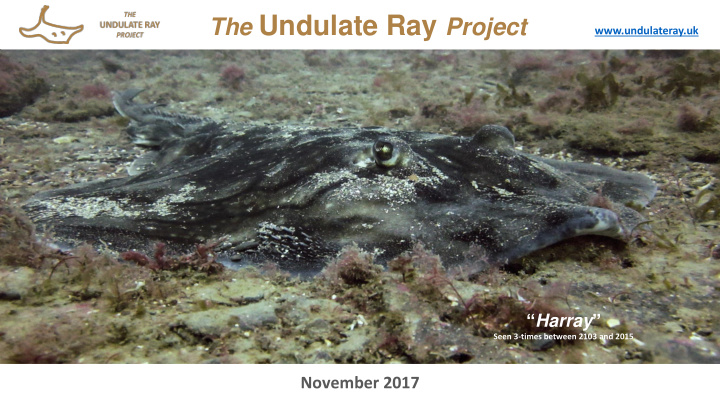



The Undulate Ray Project www.undulateray.uk “ Harray ” Seen 3-times between 2103 and 2015 November 2017
Elasmobranch Sharks Skates Rays Raja Raja brahcyura Raja clavata Raja montagui microocellata Blonde Ray Thornback Ray Spotted Ray Small-eyed Ray Raja undulata Undulate Ray www.sharktrust.org www.sharktrust.org
“Undulate” because of the movement of their wings when they swim - one of five species of “Flat Shark” or skate commonly found on the south coast “ Erayc ” Abundant in some local areas Seen in June, July and August 2017 - concerns exist about their long-term survival
Undulate Rays Grow to approximately 1-metre in length Live for about 15 to 20 years? Mature at about 8 years old Diet: mostly small crustaceans Breeds between March and June - possibly longer? Lays eggs in pairs - where? - over what period? Male Female Incubation thought to take about 90 days
Ray Identification “ Garay ” 3 September 2013 “ Garay ” 27 August 2013 “ Garay ” on 2 separate days – to be sure this is the same fish …
Ray Identification “ Garay ” 27 August 2013 “ Garay ” 3 September 2013 … we rotate the image to the same direction and remove the colour …
“ Garay ” 27 August 2013 “ Garay ” 3 September 2013 … crop and resize …
“ Garay ” 27 August 2013 “ Garay ” 3 September 2013 … and remove the background.
Ray Identification Computer software is used to identify the most likely matching photographs … Wild-ID 1.0 is free software developed by Dartmouth College that also includes free software from other sources. Employs the SIFT operator (Scale Invariant Feature Transform; Lowe 2004) freely available for academic or personal purposes.
“ Garay ” 27 August 2013 “ Garay ” 3 September 2013 … but finally we compare differences, in both photographs, between left and right sides of the fish. Rays are not truly symmetrical
Our initial interest started in 2012 at one specific Dorset location
Most UK divers report seeing one or two rays a year. On this site, about the size of a football field, we had 201 ray sightings between 2012 and 2016. To October 2017 on this site: 351 Ray Sightings 311 Undulate sightings 248 Undulates with ID photos 179 individuals 69 repeat sightings
3 where species not recorded 1 small-eyed 7 thornback 29 spotted 248 179 311 undulates with identified photographs individuals
Repeat Sightings • Data to end 2016 only • Some rays are seen Seen 3 times just a few days apart however …. Seen 3 times Seen 3 times • Rays are often seen Seen 3 times Seen 5 times again after a gap of months or years Seen 3 times Seen 4 times Seen 4 times
Conclusions A methodology has been developed to identify individual undulate rays from photographs of the pattern on their upper surface. The frequency of repeat sightings in the data, approximately 1 in 5, suggests that the overall ray population visiting the site is not large. The scarcity of single individuals being seen many times suggests the rays may visit the area on a periodic basis. Presented at Annual European Elasmobranch Association Conference, October 2016
Home About Take Part Links Contact “Blanc” Seen in Sept 2013, May and August 2017 Rays were swimming in our seas when dinosaurs walked along British shores. The undulate ray can still be found along the Jurassic Coast, but little is known about their habits and movements in the wild. This project is to explore the lifestyle of the undulate ray. ... but we need your help. “ Dierdray ” Seen in 2013 and 2016
Home About Take Part Links Contact Anglers Fishermen Divers
Home About Take Part Links Contact Take Part If you are an angler who catches an undulate ray or a diver who sees an undulate ray lying on the seabed, capture the moment, give yourself a memory with a photograph and then send it to Billy at: - billy@undulateray.uk
Home About Take Part Links Contact • 23,000+ visitors to the website (62,500+ hits) • 218 Facebook members • 83 people contributing images • 669 total ray sightings (491 individual rays)
Home About Take Part Links Contact Project Status, 7th October 2017: 474 undulate rays recorded with 58 seen on more than one day . All Data Original Site Rest of Data Undulate rays seen 637 305 332 Identified individuals 474 177 297 Number seen > 1 58 (12%) 45 (25%) 13 (4%) Returns (% of individuals) 83 (18%) 69 (39%) 34 (11%)
DNA sampling for genetic analysis
Genetic Analysis Part of a larger project with Samantha Hook from the University of Manchester to determine the genetic health of undulate ray populations and their ability for adaptation. The undulate ray project provides a unique opportunity to obtain genetic materials in a harmless and sustainable way from a live ray population. The analysis will verify the identification process and help us understand the family relationships of the rays we photograph and observe. A sampling methodology has been established and the Undulate Ray Project has successfully obtained DNA from 48 individual rays, in some cases, more than once. “Yikes” Some rays swim away but others appear to enjoy having Sampled three times in 2017 their back swabbed and stay around for more.
Thank-you www.undulateray.uk
Recommend
More recommend